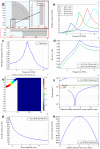Polyimide-On-Silicon 2D Piezoelectric Micromachined Ultrasound Transducer (PMUT) Array
- PMID: 37430741
- PMCID: PMC10221194
- DOI: 10.3390/s23104826
Polyimide-On-Silicon 2D Piezoelectric Micromachined Ultrasound Transducer (PMUT) Array
Abstract
This paper presents a fully addressable 8 × 8 two-dimensional (2D) rigid piezoelectric micromachined ultrasonic transducer (PMUT) array. The PMUTs were fabricated on a standard silicon wafer, resulting in a low-cost solution for ultrasound imaging. A polyimide layer is used as the passive layer in the PMUT membranes on top of the active piezoelectric layer. The PMUT membranes are realized by backside deep reactive ion etching (DRIE) with an oxide etch stop. The polyimide passive layer enables high resonance frequencies that can be easily tuned by controlling the thickness of the polyimide. The fabricated PMUT with 6 µm polyimide thickness showed a 3.2 MHz in-air frequency with a 3 nm/V sensitivity. The PMUT has shown an effective coupling coefficient of 14% as calculated from the impedance analysis. An approximately 1% interelement crosstalk between the PMUT elements in one array is observed, which is at least a five-fold reduction compared to the state of the art. A pressure response of 40 Pa/V at 5 mm was measured underwater using a hydrophone while exciting a single PMUT element. A single-pulse response captured using the hydrophone suggested a 70% -6 dB fractional bandwidth for the 1.7 MHz center frequency. The demonstrated results have the potential to enable imaging and sensing applications in shallow-depth regions, subject to some optimization.
Keywords: PMUT; PZT; medical imaging; piezo-mems; piezoelectric thin films; ultrasound transducers.
Conflict of interest statement
The authors declare no conflict of interest.
Figures








Similar articles
-
Flexible PZT-Based Row-Column Addressed 2-D PMUT Array.IEEE Trans Ultrason Ferroelectr Freq Control. 2024 Nov;71(11):1616-1626. doi: 10.1109/TUFFC.2024.3465589. Epub 2024 Nov 27. IEEE Trans Ultrason Ferroelectr Freq Control. 2024. PMID: 39312430
-
Evaluation of High Frequency Piezoelectric Micromachined Ultrasound Transducers for Photoacoustic Imaging.Proc IEEE Sens. 2018 Oct;2018:10.1109/ICSENS.2018.8589733. doi: 10.1109/ICSENS.2018.8589733. Epub 2018 Dec 27. Proc IEEE Sens. 2018. PMID: 31303903 Free PMC article.
-
A Photoacoustic Imaging Device Using Piezoelectric Micromachined Ultrasound Transducers (PMUTs).IEEE Trans Ultrason Ferroelectr Freq Control. 2020 Apr;67(4):801-809. doi: 10.1109/TUFFC.2019.2956463. Epub 2019 Nov 28. IEEE Trans Ultrason Ferroelectr Freq Control. 2020. PMID: 31794394 Free PMC article.
-
Piezoelectric Micromachined Ultrasound Transducer Technology: Recent Advances and Applications.Biosensors (Basel). 2022 Dec 29;13(1):55. doi: 10.3390/bios13010055. Biosensors (Basel). 2022. PMID: 36671890 Free PMC article. Review.
-
Review of pMUTs for medical imaging: towards high frequency arrays.Biomed Phys Eng Express. 2023 Jan 12;9(2). doi: 10.1088/2057-1976/acaab2. Biomed Phys Eng Express. 2023. PMID: 36595267 Review.
Cited by
-
Design and Fabrication of High-Performance Piezoelectric Micromachined Ultrasonic Transducers Based on Aluminum Nitride Thin Films.Micromachines (Basel). 2024 Aug 1;15(8):1001. doi: 10.3390/mi15081001. Micromachines (Basel). 2024. PMID: 39203652 Free PMC article.
-
Flexible micromachined ultrasound transducers (MUTs) for biomedical applications.Microsyst Nanoeng. 2025 Jan 16;11(1):9. doi: 10.1038/s41378-024-00783-5. Microsyst Nanoeng. 2025. PMID: 39814707 Free PMC article. Review.
References
-
- De Luca R., Forzoni L., Gelli F., Bamber J. An educational overview of ultrasound probe types and their fields of application. Arch. Acoust. 2021;46:3–15.
-
- Chen A.I.H., Wong L.L.P., Yeow J.T.W. Medical Imaging: Technology and Applications. CRC Press; Boca Raton, FL, USA: 2013. pp. 253–271.
-
- Shung K.K., Zippuro M. Ultrasonic transducers and arrays. IEEE Eng. Med. Biol. Mag. 1996;15:20–30. doi: 10.1109/51.544509. - DOI
-
- Stephens D.N., Truong U.T., Nikoozadeh A., Oralkan Ö., Seo C.H., Cannata J., Dentinger A., Thomenius K., De La Rama A., Nguyen T., et al. First in vivo use of a capacitive micromachined ultrasound transducer array–based imaging and ablation catheter. J. Ultrasound Med. 2012;31:247–256. doi: 10.7863/jum.2012.31.2.247. - DOI - PMC - PubMed
LinkOut - more resources
Full Text Sources
Miscellaneous

